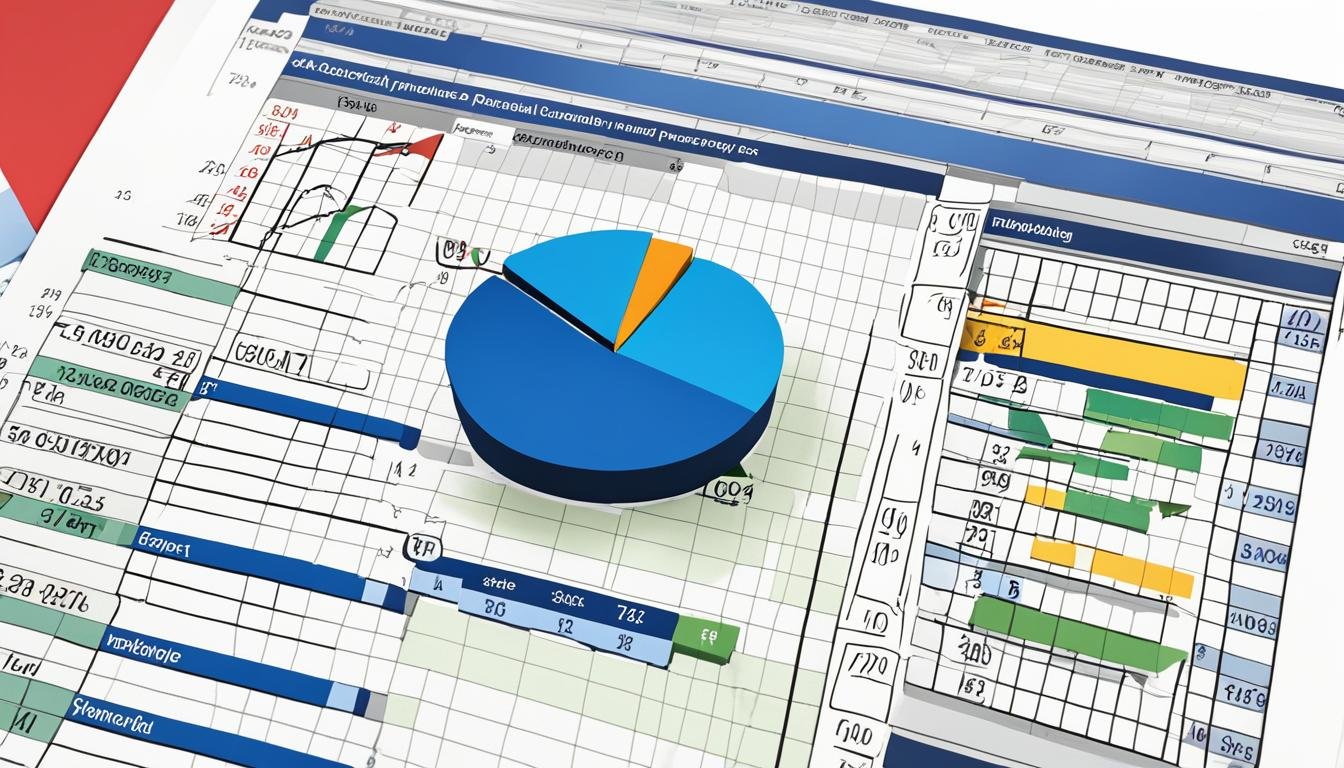Financial Modeling Essentials: Key Concepts Guide
Financial modeling plays a pivotal role in the finance industry, as it encompasses the core principles and methodologies employed to develop reliable models for analyzing and forecasting financial results. Proficiency in financial modeling empowers finance professionals to navigate the complex terrain of the financial landscape with accuracy and assurance. This comprehensive guide aims to delve into the vital concepts and techniques necessary for constructing impactful financial models, equipping individuals with the expertise to make well-informed financial choices and achieve triumph in the ever-evolving realm of finance.
Key Takeaways:
- Financial modeling is crucial for accurately analyzing and forecasting financial outcomes.
- Proficiency in financial modeling is essential for success in the finance industry.
- Constructing impactful financial models requires understanding key concepts and techniques.
- Well-informed financial choices are facilitated by effective financial modeling.
- Continuous learning and adaptation are vital in the dynamic world of financial modeling.
What is Financial Modeling?
Financial modeling entails constructing mathematical models to replicate real-life financial situations. These models facilitate the analysis and projection of financial outcomes, serving as invaluable aids in financial analysis, valuation, and risk management. Mastery of financial modeling is essential for individuals seeking to excel in these areas and navigate the intricate world of finance confidently.
Importance of Financial Modeling in Decision-Making
Financial modeling plays a crucial role in decision-making processes across various industries, offering a structured and quantitative framework for analyzing financial data. It provides valuable insights into potential outcomes, risks, and returns, empowering decision-makers to make informed choices that drive business success.
By utilizing financial models, decision-makers can assess the potential impact of different scenarios on their organizations, evaluate the risks associated with each option, and identify opportunities for maximizing returns. Financial modeling enables a systematic and comprehensive analysis of financial data, facilitating a deeper understanding of the potential consequences of different decisions.
“Financial modeling equips decision-makers with the tools and insights needed to make strategic choices based on sound financial analysis and evaluation.”
Furthermore, financial modeling strengthens risk management practices by quantifying and assessing the risks involved in various decision outcomes. By identifying potential risks and their potential impact on financial performance, decision-makers can implement risk mitigation strategies and make well-informed decisions that minimize potential pitfalls.
The accuracy and reliability of financial models enhance decision-making by providing a solid foundation for evaluating the financial feasibility of projects, investments, and strategic initiatives. By quantifying the expected returns and financial implications, decision-makers can prioritize and allocate resources effectively, ensuring a higher likelihood of success.
In summary, financial modeling plays a vital role in decision-making by providing a quantitative and systematic approach to analyzing financial data. Its importance lies in its ability to enhance decision-making accuracy, strengthen risk management practices, and drive overall business achievements.
**
Benefits of Financial Modeling in Decision-Making:
**
- Quantitative analysis of potential outcomes, risks, and returns
- Enhanced decision-making accuracy
- Strengthened risk management practices
- Improved allocation of resources
- Optimized financial feasibility evaluation
**
Example of Financial Modeling in Decision-Making:
**
| Scenario | Expected Returns | Risk Assessment |
|---|---|---|
| Investing in a new product line | $1 million revenue potential | High competition and market saturation |
| Expanding into a new market | 20% annual revenue growth | Political and economic instability |
| Acquiring a competitor | Economies of scale and market dominance | Integration challenges and regulatory risks |
By utilizing financial modeling, decision-makers can evaluate the potential returns, assess the associated risks, and make well-informed decisions that align with the organization’s strategic goals.
Objectives of Financial Modeling
In the world of finance, financial modeling serves as a versatile tool that helps organizations achieve their goals. By meticulously analyzing historical performance, developing forecasts and scenarios, assessing risk, comparing companies or industries, facilitating financial planning and budgeting, and aiding business decision-making, financial modeling empowers individuals to make informed choices that drive success.
One of the primary objectives of financial modeling is to analyze historical performance. By examining past financial data, organizations can gain valuable insights into their strengths and weaknesses, identify patterns and trends, and make informed decisions based on historical outcomes.
“Analyzing historical performance through financial modeling allows organizations to learn from their past experiences, capitalize on successes, and rectify any areas of improvement.”
Financial modeling also plays a crucial role in developing forecasts and scenarios for future performance. By leveraging historical data, industry trends, and market conditions, organizations can project their financial performance and estimate potential outcomes in different scenarios, enabling them to plan and strategize effectively.
Risk assessment is another key objective of financial modeling. By incorporating risk factors and uncertainties into financial models, organizations can evaluate the potential risks associated with different decisions and identify strategies to mitigate them. This allows businesses to make more calculated and risk-aware choices.
Furthermore, financial modeling facilitates the process of comparing companies or industries. By constructing detailed financial models, organizations can analyze and benchmark the performance of different companies or industries, enabling them to identify key areas of competitive advantage or areas for improvement.
Financial modeling also plays a pivotal role in financial planning and budgeting. By creating comprehensive financial models, organizations can assess the financial implications of various strategies and initiatives, helping them develop effective financial plans and budgets aligned with their overall objectives.
Last but not least, financial modeling aids in making business decisions. By providing a quantitative framework for evaluating various scenarios and analyzing the financial impact, financial modeling empowers decision-makers to make well-informed choices that drive business growth and success.
As financial modeling caters to a wide range of objectives, it has become an indispensable tool for organizations seeking to make sound financial decisions, mitigate risks, and achieve their goals.
Benefits of Financial Modeling Objectives:
- Enhanced decision-making through informed insights
- Improved risk assessment and mitigation
- Better strategic planning and forecasting
- Effective comparison of companies or industries
- Optimized financial planning and budgeting processes
- Aligned business decisions with long-term objectives
How Financial Modeling Works
Financial modeling is a powerful tool that leverages historical financial data, assumptions, and formulas to create models that simulate real-world financial scenarios. By utilizing quantitative techniques, financial modeling provides valuable insights into financial performance, investments, and risks, enabling informed decision-making in the dynamic landscape of finance.
At its core, financial modeling involves the systematic process of constructing models that accurately represent a company’s financial situation. This requires gathering historical financial data, such as income statements, balance sheets, and cash flow statements, to establish a foundation for analysis.
Using these historical data points, financial modelers can make assumptions about future scenarios and variables. These assumptions can include factors like revenue growth rates, expense trends, interest rates, and market conditions.
To transform these assumptions into meaningful outputs, financial modelers use formulas and calculations. These formulas can range from basic arithmetic calculations to more complex calculations involving discounted cash flows, rate of returns, and valuation techniques.
By inputting the historical financial data and assumptions into the model, quantitative outputs are generated. These outputs can include projected financial statements, profitability ratios, return metrics, and other data that can aid in decision-making and financial analysis.
It is important to note that financial modeling is an iterative process that requires continuous monitoring and refinement. As market conditions change, new historical data becomes available, or assumptions need to be adjusted, the financial model must be updated to reflect these changes. This ensures that the model remains accurate and relevant in an ever-evolving financial landscape.
| Financial Modeling Components | Description |
|---|---|
| Historical Financial Data | Gathering and analyzing financial statements and other historical data to establish a baseline for the model. |
| Assumptions | Making educated assumptions about future variables and scenarios based on industry knowledge and market conditions. |
| Formulas and Calculations | Utilizing mathematical formulas and calculations to transform assumptions and data into quantitative outputs. |
| Quantitative Outputs | Generating financial statements, performance metrics, and other data to provide insights into financial performance and risks. |
Financial modeling serves as a foundation for strategic planning, investment analysis, budgeting, and other critical financial decisions. It enables individuals and organizations to evaluate potential outcomes, assess risks, and determine optimal strategies for growth and profitability.
Next, we will explore how Excel, a widely used spreadsheet software, can be leveraged for financial modeling.
Excel for Financial Modeling
When it comes to financial modeling, Excel is an indispensable tool that offers a wide range of essential functions, formulas, and calculations. Excel’s versatility and user-friendly interface make it the go-to software for finance professionals to create powerful and accurate financial models.
Below are some of the key functions and formulas commonly used in financial modeling:
Aggregating Data
- SUM: Calculates the sum of a range of cells.
- SUMPRODUCT: Multiplies corresponding arrays and returns the sum of those products.
Conditional Calculations
- IF: Performs a specified calculation if a condition is true, and another calculation if the condition is false.
- IFERROR: Returns a specified value if a formula evaluates to an error, and the result of the formula if it doesn’t.
Discounted Cash Flow Analysis
- NPV (Net Present Value): Calculates the present value of future cash flows and compares it to an initial investment.
- IRR (Internal Rate of Return): Determines the rate of return where the NPV of cash flows reaches zero.
Data Retrieval
- VLOOKUP: Extracts data from a specific column in a table based on a specified value in another column.
- INDEX-MATCH: Retrieves a value from a table based on a specified row and column index.
Loan Payment and Investment Value Calculations
- PMT: Calculates the periodic payment for a loan based on interest rate, principal amount, and loan term.
- FV: Computes the future value of an investment based on periodic additions, interest rate, and investment period.
Proficiency in using these Excel functions and formulas is crucial for effective financial modeling. By harnessing Excel’s power, finance professionals can perform complex calculations, analyze data, and create comprehensive financial models that drive strategic decision-making.
| Function/Formula | Description |
|---|---|
| SUM | Calculates the sum of a range of cells. |
| SUMPRODUCT | Multiplies corresponding arrays and returns the sum of those products. |
| IF | Performs a specified calculation if a condition is true, and another calculation if the condition is false. |
| IFERROR | Returns a specified value if a formula evaluates to an error, and the result of the formula if it doesn’t. |
| NPV (Net Present Value) | Calculates the present value of future cash flows and compares it to an initial investment. |
| IRR (Internal Rate of Return) | Determines the rate of return where the NPV of cash flows reaches zero. |
| VLOOKUP | Extracts data from a specific column in a table based on a specified value in another column. |
| INDEX-MATCH | Retrieves a value from a table based on a specified row and column index. |
| PMT | Calculates the periodic payment for a loan based on interest rate, principal amount, and loan term. |
| FV | Computes the future value of an investment based on periodic additions, interest rate, and investment period. |
How to Build a Financial Model
Building a financial model is a systematic process that involves several key steps to ensure accuracy and effectiveness. Let’s explore each step in detail:
1. Define the Objective
The first step in building a financial model is to clearly define the objective. This involves identifying the purpose of the model, such as evaluating the financial feasibility of a business venture, analyzing investment opportunities, or forecasting future financial performance.
2. Gather Relevant Data
Once the objective is defined, the next step is to gather relevant data. This includes financial statements, market research, industry benchmarks, economic indicators, and any other data sources needed to support the model’s analysis and projections.
3. Structure the Model
Structuring the model involves organizing the data and building the framework for calculations. This includes setting up worksheets, defining input cells for variables, and creating formulas to calculate outputs based on the gathered data.
4. Identify Variables and Assumptions
In this step, it is important to identify the variables and assumptions that will drive the model’s calculations. These variables can include revenue growth rates, cost structures, interest rates, inflation rates, and other factors that impact financial performance.
5. Build Formulas and Calculations
Building formulas and calculations is a critical step in constructing a financial model. This involves using mathematical and financial functions in spreadsheet software, such as Excel, to perform calculations based on the identified variables and assumptions.
6. Validate and Test the Model
After building the model, it is crucial to validate its accuracy and test its functionality. This involves comparing the model’s outputs to historical data or industry benchmarks to ensure it is producing reliable results. Testing also helps identify any errors or issues that need to be addressed.
7. Document Assumptions and Methodology
Documenting assumptions and methodology is essential for transparency and future reference. Capturing all assumptions made during the model building process, as well as documenting the methodology used for calculations, ensures clarity and helps others understand and replicate the model.
8. Analyze and Interpret Results
Once the model is validated and documented, it is time to analyze and interpret the results. This involves carefully examining the outputs and assessing the financial implications and insights derived from the model’s projections.
9. Present the Findings
Lastly, presenting the findings of the financial model is crucial to effectively communicate the analysis and conclusions to stakeholders. This can be done through reports, presentations, or interactive dashboards that visually represent the model’s outputs and key takeaways.
Building a financial model requires attention to detail, thorough analysis, and adherence to best practices. By following these steps, finance professionals can construct robust and reliable financial models that contribute to informed decision-making and successful business outcomes.
Advanced Financial Modeling Techniques
In the field of finance, advanced financial modeling techniques play a crucial role in maximizing the accuracy and effectiveness of financial analysis and decision-making processes. These advanced techniques go beyond the foundational concepts of financial modeling and delve into sophisticated methodologies that provide deeper insights into potential outcomes, risks, and opportunities.
Scenario Analysis
Scenario analysis is a powerful technique used in financial modeling to assess potential outcomes by considering various plausible scenarios. By analyzing different scenarios, finance professionals can evaluate the impact of key variables on financial performance and make more informed decisions. This technique allows for a comprehensive exploration of both optimistic and pessimistic scenarios, enabling organizations to develop robust strategies to mitigate risks and capitalize on opportunities.
Monte Carlo Simulation
Monte Carlo simulation is a probabilistic modeling technique that aids in analyzing uncertainty and risk within financial models. By generating random inputs based on specified probability distributions, Monte Carlo simulation enables finance professionals to simulate a wide range of possible outcomes. This powerful technique provides a more comprehensive understanding of the uncertainties associated with key variables and aids in the development of risk mitigation strategies.
Sensitivity Analysis
Sensitivity analysis is utilized in financial modeling to evaluate the dependence of financial outcomes on specific variables. By systematically varying key assumptions and observing the resulting changes in the model’s output, finance professionals can understand the sensitivity and responsiveness of the model to these variables. Sensitivity analysis provides valuable insights into the drivers of financial performance and assists in identifying critical factors that can significantly impact decision-making.
Capital Budgeting
Capital budgeting involves analyzing and evaluating investment opportunities to determine the viability and profitability of projects. Advanced financial modeling techniques in capital budgeting go beyond simple calculations and incorporate complex considerations such as the time value of money, risk assessment, and sensitivity analysis. By employing these techniques, organizations can make more accurate investment decisions and allocate resources effectively.
Valuation Methods
Advanced financial modeling techniques also encompass a wide range of valuation methods that aid in assessing the intrinsic value of assets, companies, or projects. These methods include discounted cash flow (DCF) analysis, comparable company analysis, precedent transactions analysis, and option pricing models. By utilizing these techniques, finance professionals can determine appropriate valuation multiples, assess investment attractiveness, and support strategic decision-making.
Dynamic Modeling
Dynamic modeling is a technique that recognizes the fluid nature of business and incorporates changing variables and assumptions into financial models. Unlike static models, dynamic models evolve over time by considering new information and adjusting projections accordingly. By embracing dynamic modeling, organizations can capture the complexities of real-world scenarios and enhance the accuracy and reliability of their financial models.
Data Analysis and Visualization
Data analysis and visualization techniques are critical in advanced financial modeling to extract meaningful insights from complex datasets. By leveraging statistical analysis, data mining, and visualization tools, finance professionals can identify patterns, trends, and correlations within financial data. These insights enable organizations to make data-driven decisions, communicate complex information effectively, and support strategic planning and performance monitoring.
By harnessing the power of these advanced financial modeling techniques, finance professionals can elevate their financial analysis, decision-making, and strategic planning capabilities. These techniques provide valuable insights, enhance risk management practices, and empower organizations to thrive in a dynamic and competitive business environment.
Conclusion
Financial modeling is an essential skill for individuals and organizations seeking to make well-informed financial decisions and achieve success in the finance industry. This comprehensive guide has explored the core concepts and techniques of financial modeling, equipping readers with the necessary knowledge and skills to navigate the complexities of financial analysis, forecasting, investment analysis, business planning, valuation techniques, financial planning, and budgeting.
By mastering the essentials of financial modeling, individuals can confidently analyze and interpret financial data, make informed decisions, and drive business achievements. Financial models provide a structured and quantitative framework for decision-making, enabling individuals to assess risks, evaluate potential outcomes, and identify opportunities for growth and success.
Whether it’s projecting future financial performance, conducting investment analysis, or developing business plans, financial modeling serves as a powerful tool that enhances decision-making accuracy and empowers individuals to navigate the dynamic landscape of finance. By integrating financial modeling into their processes, individuals can gain deeper insights into their financial data and make strategic choices that drive success.







